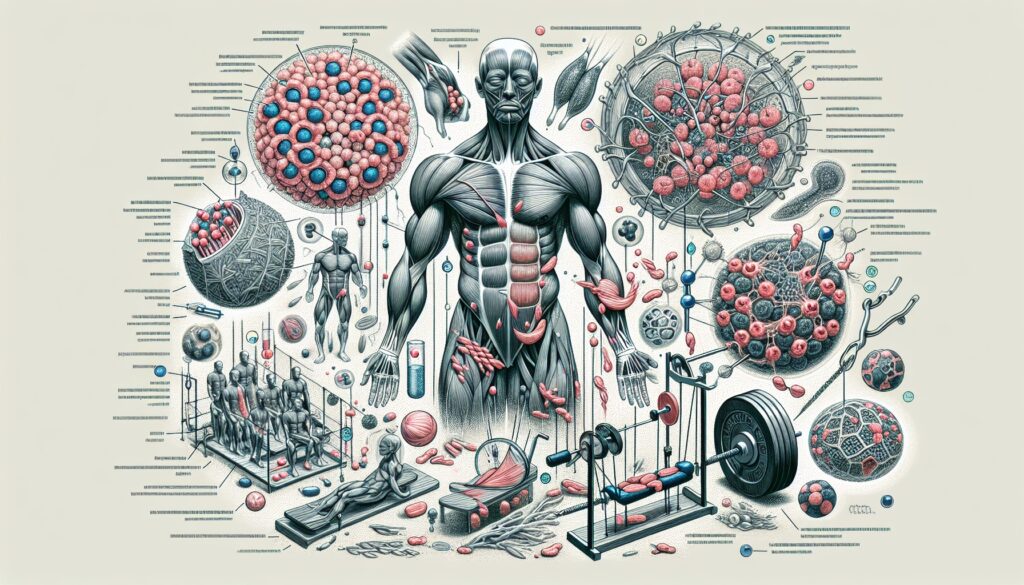Scientific Strategies for Muscle Hypertrophy: Achieve Your Fitness Goals
Discover the muscle hypertrophy science behind effective training and nutrition to achieve your fitness goals.

Understanding Muscle Hypertrophy
Muscle hypertrophy is a key idea for those diving into fitness and bodybuilding. Here, we’ll break down what it all means and the different kinds of muscle growth that can happen.
Definition and Importance
Muscle hypertrophy is about making your muscles bigger and stronger. This usually happens when you lift weights or do other types of strength training. It’s important for athletes, bodybuilders, and those who love working out, since more muscle can make you look better and perform better. Plus, having more muscle can speed up your metabolism and help your body work better overall.
Types of Muscle Hypertrophy
Knowing the types of muscle hypertrophy can help tailor workouts to meet specific goals. The main types are:
| Type of Hypertrophy | Description |
|---|---|
| Myofibrillar Hypertrophy | This boosts the size and count of the muscle fibers that help you lift, leading to more strength. You get this from lifting heavy weights. |
| Sarcoplasmic Hypertrophy | Focuses on increasing the muscle cell fluid and energy stores. It’s more about stamina and is common in those who lift lighter weights more times. |
Adjusting how you train can focus on these different effects. If you’re curious about which exercises hit these goals best, take a look at our guide on the best exercises for muscle hypertrophy.
To wrap it up, knowing what muscle hypertrophy means and its types helps you decide on the right workouts. Whether you’re shooting for raw power or more endurance, getting a grip on these distinctions is key to hitting your fitness targets. For more on training approaches, you might want to dive into muscle hypertrophy training techniques or check out some muscle hypertrophy supplements that can support muscle growth.
Mechanisms of Muscle Growth
Muscle hypertrophy, or beefing up those muscles, ain’t just about hitting the weights – it’s a wild dance of multiple body systems coming together. Get to grips with what really gets your muscles bulging and you could be well on your way to maximized gains from your workouts.
Mechanical Damage and Repair
Slamming those weights isn’t just about moving steel. When you lift, you’re actually doing a bit of controlled destruction on your muscle fibers, creating tiny tears that set off a flurry of renovation in your body. This repair work fuels muscle growth, although it can leave you feeling stiff and a bit wobbly at first. But don’t worry, it’s all part of the muscle-boosting magic. Those eccentric movements – think letting the weights down slowly in a bicep curl – pack the hardest punch in terms of damage.
| Damage Mechanism | What’s Happening |
|---|---|
| Muscle Tear | Kickstarts repair and muscle building |
| Decreased Force | Means you’ve gotta push harder next time |
| Satellite Cell Activation | Heals and beefs up the muscle |
Metabolic Stress for Growth
Ever feel like your muscles are about to tap out during a workout? That’s metabolic stress stepping in. When your muscle cells run low on their energy stash (ATP), they start sending out stress signals in the form of lactate build-up. While this might make you feel like your muscles are on fire, it’s a good thing for growth. This stress, when teamed up with the physical damage, cranks up the muscle growth process.
| Stress Type | What’s the Deal? |
|---|---|
| ATP Exhaustion | Drains energy and tires out muscles |
| Lactate Buildup | Waves the flag for muscle growth |
| Hormonal Release | Fuels recovery and more muscle |
Muscle Tension for Gains
The secret sauce to muscle growth lies in muscle tension. This is the force your muscles exert during a lift, and it’s crucial for size gains. Load up those weights, add more reps, and keep pushing, because these apply the right pressure your muscles need to grow. High tension activates those muscle fibers, turning your efforts into genuine growth.
| Training Tactics | Boosting Muscle Tension |
|---|---|
| Load | Heavyweights amp up the tension |
| Volume | Extra reps mean longer stress |
| Frequency | Regular workouts mean muscles stay on their toes |
Understanding these muscle-pumping mechanisms allows fitness buffs to tweak their workout game and nutrition to chase better results. If you’re hunting for killer exercises and cutting-edge training strategies, check out best exercises for muscle hypertrophy and muscle hypertrophy training techniques for a deep dive into the good stuff.

Genetic Factors in Hypertrophy
Genes are like little puppeteers when it comes to muscle growth, pulling the strings on how we handle exercise and just how buff we can get. Get to know these genetic players, and you might just unlock the secret formula for maximizing those gains.
Myostatin-Related Hypertrophy
Imagine there’s a superhero gene called MSTN, and when it goes rogue, it results in a rare condition known as myostatin-related muscular hypertrophy. In this genetic twist, your muscle mass can double the norm because of a slacker called myostatin, which usually holds muscle growth in check. Folks with this quirky genetic trait pack on muscle like nobody’s business, with barely any body fat and no nasty health hiccups to worry about.
| Characteristic | Average Joe | Myostatin Marvel |
|---|---|---|
| Muscle Mass | Typical | Up to twice as hefty |
| Body Fat | Meh to chunky | Slim pickings |
| Health Issues | Hit or miss | Pretty rare |
Spotting someone with this genetic jackpot involves some fancy genetic tests, or trusty tools like ultrasounds and calipers to gauge how little fat they’ve got.
Influence of DNA and Gender
Your DNA isn’t just for show—it’s got a big say in your muscle magic and how well you tackle resistance workouts. Some folks are blessed with fast-twitch muscle fibers, making them kings and queens of explosive movements and greater muscle bulk.
Turns out, being born male comes with a bonus: higher testosterone levels. This hormone is the secret sauce for muscle growth, giving guys an edge over gals in the hypertrophy race. But let’s not count women out—they can still flex substantial gains, though their genetic programming and hormonal setup may pace the progress.
| Factor | Men | Women |
|---|---|---|
| Testosterone Levels | Pumped up | Less intense |
| Muscle Fiber Composition | Speed demons | Endurance aficionados |
| Hypertrophy Potential | Maximum gains | Solid, but slower gains |
Knowing your genetic blueprint can help fine-tune your workouts and set realistic goals for those muscle dreams. If you’re keen on squeezing every bit of progress from your sweat sessions, don’t forget to consider both the inside scoop of muscle hypertrophy supplements and the right moves in your best exercises for muscle hypertrophy arsenal to sync up with your unique genetic quirks.
Training Strategies for Hypertrophy
Getting those muscles to grow isn’t magic—it’s science with a bit of sweat. How you tackle your strength and resistance training can make all the difference in building muscle mass.
Strength Training Principles
Strength training? Think of it as the blueprint for bulking up. By using resistance, you’re basically telling your muscles, “Hey, wake up and grow!” This process causes tiny tears in your muscle fibers, and while it might not sound pretty, it’s how you get bigger and stronger. The body steps up to the challenge by repairing these tears, making your muscles beefier with each fix. It’s a good idea to hit the major muscle groups at least a couple of times a week, and don’t skimp on rest between sets—your muscles need their downtime, too. Keep the weights climbing gradually to keep your muscles guessing and growing (Medical News Today).
Strength Training Cheat Sheet
| Experience Level | Sets per Exercise | Repetitions | Percent of 1RM (One-Rep Max) |
|---|---|---|---|
| Newbies | 1−3 | 8−12 | 70−85% |
| Seasoned Pros | 3−6 | 1−12 | 70−100% |
The American College of Sports Medicine thinks these are solid moves for bulk and burnout (NCBI).
Resistance Training Techniques
Mixing up how you resist can make muscles pop. Spice up your routine with these power-packed ideas:
- Drop Sets: Push till you can’t anymore, then drop some weight and keep going. This trick keeps muscles guessing and growing.
- Supersets: Go from one exercise to another without much breather. Hit the same muscles or mix it up with different ones.
- Cluster Sets: Take your regular set but slice it into smaller parts, with short breaks in between—perfect for keeping it intense.
- Eccentric Tempo: Slow it down when lowering weights to up the intensity and muscle growth magic.
- Blood Flow Restriction: Put a band on it—literally. Light weights with restricted blood flow can pack a punch in muscle gains.
These techy tweaks can add that extra oomph to your regime (NCBI). If you’re itching for more muscle-growing magic, we’ve got the goods on best exercises for muscle hypertrophy and muscle hypertrophy training techniques. Check it out!

Nutrition and Muscle Growth
Eating right plays a big part in bulking up those muscles. There’s a superstar nutrient here, and that’s protein.
Protein Intake for Hypertrophy
Getting enough protein in your diet is crucial not just for staying healthy, but also for building muscle. The usual suggested protein intake is often taken the wrong way; it’s really just the minimum to avoid losing muscle, not necessarily the most for muscle-building magic. New studies show that eating more protein can get you stronger and help grow those muscles when you’re hitting the gym hard.
Chowing down on more protein gives you some nifty perks:
- Keeps that muscle from disappearing when you’re cutting calories
- Fights off the muscle sag that comes with age
- Pumps up muscle protein building, especially if you spread it out over meals
To break down how much protein you need to muscle up, here’s a helpful guide based on how active you are:
| Activity Level | Recommended Protein Intake (g/kg body weight) |
|---|---|
| Couch Potato | 0.8 |
| Cardio Buff | 1.2 – 1.4 |
| Weight Lifter | 1.6 – 2.2 |
| Bodybuilder | 1.6 – 2.2 |
Importance of Protein Synthesis
Think of protein synthesis as your muscles’ personal construction crew. It’s what rebuilds and grows your muscle tissue, reacting to those workouts. Eating protein at different times can tweak this process. Experts say to load up on protein in the morning and have a smaller punch before bed to really boost muscle rebuilding (NCBI).
So keeping those amino acids handy, like overnight during sleep, is key. Planning when you eat protein helps rev up that muscle growth and recovery.
If you’re keen to learn more about bulking up, check out some training techniques here or look into supplements here that could give your fitness goals a little extra kick.
Hormonal Influence on Hypertrophy
If you’re serious about upping your fitness game and getting those muscles to grow, you gotta know how hormones come into play. These little chemical messengers, plus growth factors, have a big say in muscle building, using a bunch of body tricks to get the job done.
Hormones and Growth Factors: What They Do
Let’s talk about IGF1, that’s Insulin-like Growth Factor 1 if you wanna get fancy. It’s one of the main players in getting muscles to grow. IGF1 flips the switch on something called the PI3K-Akt-mTOR path, which is a tongue-twister but super important ’cause it kickstarts muscle growth. This path tells muscle cells to grow and copy themselves, pumping up that muscle mass (NCBI).
Different hormones have their own ways of messing with your muscle size. Here’s a quick look at some of the big ones and how they affect your muscle-building efforts:
| Hormone | Effect on Muscle Mass |
|---|---|
| IGF1 | Gets muscles growing via the PI3K-Akt-mTOR path |
| Myostatin | Puts a brake on muscle growth |
| Follistatin | Encourages growth by keeping myostatin in check |
| Androgens | Boosts muscle growth by helping satellite cells multiply |
Hormones at Work in Muscle Building
Androgens, like testosterone, aren’t just there to give you facial hair; they’re crucial for bulking up muscles. They help out satellite cells to multiply and join up, making muscle fibers grow stronger and bigger.
Then there’s myostatin, a bit of a party pooper. It keeps a check on how big and beefy your muscles get. If you’ve got too much of it, gaining muscles can become an uphill task. Follistatin to the rescue! It stops myostatin from doing its thing, promoting muscle growth. Getting the balance right between these hormones is the secret sauce for understanding how your body builds muscle (NCBI Reference).
For those on a muscle-building mission, checking out muscle hypertrophy supplements could give you a little edge along with good training and eating habits. Sorting out your hormones the right way can make the most of your efforts, especially when paired with top-notch muscle hypertrophy training techniques and killer exercises for muscle hypertrophy.

